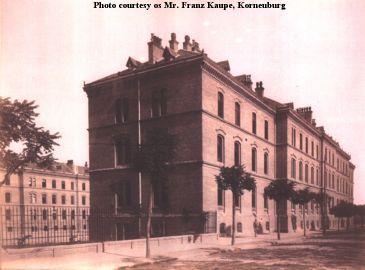![]()

 IV.
Láger Life
IV.
Láger Life
February - July, 1957
Hungarian is an extremely expressive language. There is very little ambiguity; there is always a unique word for every nuance of an idea and every idea has its own special word. Where a suitable word does not exist, the Hungarians are not shy about borrowing one from another language. So it is with Láger. I think it is a German word; in English, it can be translated as "camp", but that gives the impression of a boy scout or a military activity. It is a place where displaced people live, hopefully temporarily. We lived in such a "camp" from February through July, 1957. To me, the word Láger captures our feeling of despair commingled with the anxiety and excitement of an uncertain, but hopefully better tomorrow.
 Korneuburg
We arrive at the Schwedischelager (Swedish Láger)
around the end of January, after we are expelled from the
convent. This camp was, I believe, funded by Sweden
expressly for Hungarian Jewish refugees. This makes the
second time in recent memory that the Swedes have come to
the aid of Hungarian Jews -- in 1944, diplomat Raoul
Wallenberg saved countless Jews from certain death in
Budapest by issuing Swedish papers to them and accommodating
them in Swedish safe houses. Wallenberg was ultimately
kidnapped by the Soviets after they "liberated" (read
"occupied") Hungary, and he was never seen again.
Korneuburg
We arrive at the Schwedischelager (Swedish Láger)
around the end of January, after we are expelled from the
convent. This camp was, I believe, funded by Sweden
expressly for Hungarian Jewish refugees. This makes the
second time in recent memory that the Swedes have come to
the aid of Hungarian Jews -- in 1944, diplomat Raoul
Wallenberg saved countless Jews from certain death in
Budapest by issuing Swedish papers to them and accommodating
them in Swedish safe houses. Wallenberg was ultimately
kidnapped by the Soviets after they "liberated" (read
"occupied") Hungary, and he was never seen again.
The Láger was a former military barracks on the edge of the picturesque village of Korneuburg, situated on the banks of the Danube River. Click here to see the Escape Map. We live dormitory style in large halls, accommodating maybe 40 people each. Each of the four or so buildings (I can't remember the exact number) consist of maybe three stories, each with maybe two large halls. Each family occupies one or more bunk beds, depending on their numbers, with a little space between them. They would drape bedsheets around their bunks for privacy. My mother and I have one bunk; I sleep on top, she on the bottom There is a large communal bathroom on every floor and a huge mess hall in a separate building where everyone takes their meals.
(Mr. Franz Kaupe, a resident of Korneuburg, has completed an extensive research study on the Láger and has prepared an excellent report. He and the Mayor of Korneuburg are graciously making this report available in memory of this event. Please click here to read this report.)
Life becomes more or less routine. Of the Hungarian refugees, there are people representing every imaginable skill, trade and profession. A school is quickly established staffed by professional teachers; (is it really for the benefit of the kids or the parents?) The clinic is augmented by refugee nurses and doctors, while clothes are fashioned by the tailors and seamstresses from within our ranks. In fact, the láger is self sufficient, other than the materials which are supplied by our hosts.
The months we spend there are some of the most memorable times of my life. There are dozens of kids my age; we roam the compound, exploring every nook and cranny, playing in the nearby fields and woods. Sometimes, we would hike several miles to the castle in nearby Stockerau. Other times, we would wander through the village, to the banks of the Danube and reflect on our plight. The water we see flowing serenely by would, in a matter of time, be coursing through Hungary, past Budapest, past my grandmother's home. Maybe she would be thinking of us, wondering how we are getting along.
Every couple of weeks the $5.00 bill would arrive from Uncle Béla in New York, wrapped in a nylon stocking. The next day we would take the 30 minute commuter train ride to Vienna for the usual ritual - pastry and coffee in a café, the bath at the Dianabad and, of course, the Prater. Sometimes, we would buy some clothing or maybe a toy for me.
Later in the spring, the circus comes to Korneuburg and erects their "big top" right on the láger property. The animal cages and trailers are directly below our window. Imagine waking every morning to the roar of lions and tigers! Needless to say, we manage to get into the circus for free, many times.
As the spring wears on, families would begin leaving for their new homes. Each refugee family would have applied for admission to the country of their choice and would wait until their turn came up. The most popular destinations are the United States, Canada, Australia, Israel, Brazil and Argentina. Few remain in Austria or move on to western Europe. Fewer still would become unbearably homesick and return to Hungary to face certain punishment and ridicule. Since we were among the late arrivals in Austria (most people left Hungary in November and early December) we have to wait longer for our turn.
St. Pölten Around early June, we are transferred to another láger at St. Pölten (see map). I don't know exactly why, maybe the number of people remaining at Korneuburg is too small to make such a large facility cost effective. In any event, we are now in the Alpine foothill, with the snow capped mountains not far off. I really don't remember much of our stay here except that it was fairly brief and the nearby roads are very winding.
Schwechat Travelers to Europe will recognize this village as the home of the Vienna International Airport. We are moved here, to another military style compound, in preparation for our long awaited flight to Canada. For the ten days we spend there, I am glued to our window for hours on end, watching planes with foreign markings come and go. My favorite is the white Air France "triple-tailed" plane (probably a Lockheed Constellation) taking off for Paris every evening, around sundown. Perhaps this is the place where my fascination and interest in aviation is aroused.
Every day, lists are posted with the names of the families who will be leaving the following day. On July 2, 1957, our name is on the list for Canada.
|
III. Vienna |
Return to Home Page |
V. Canada |